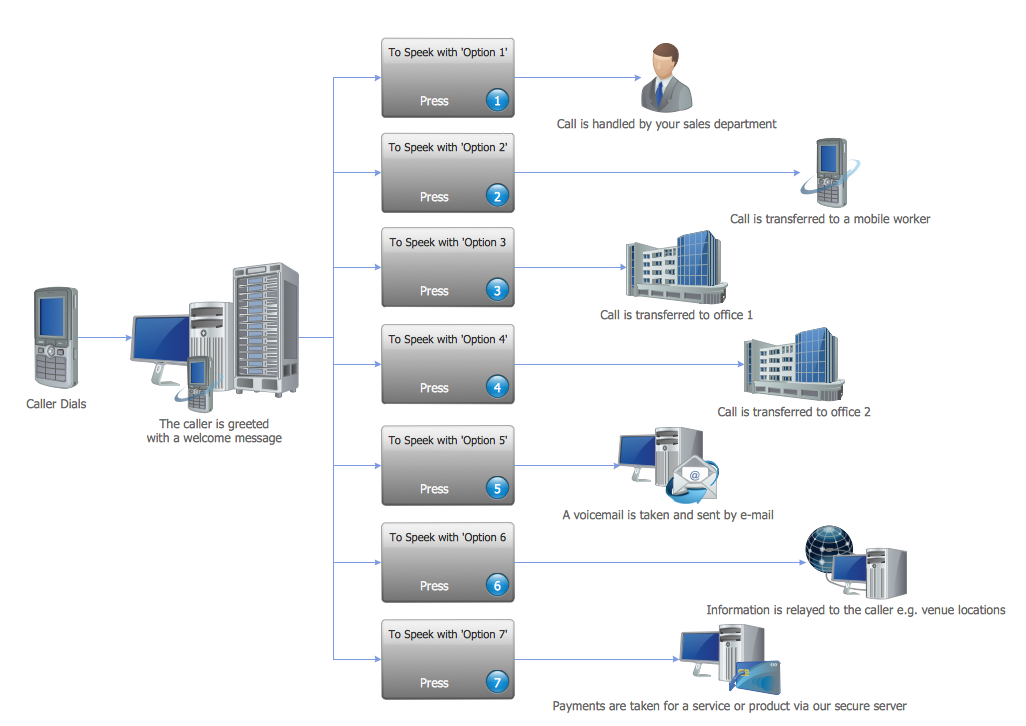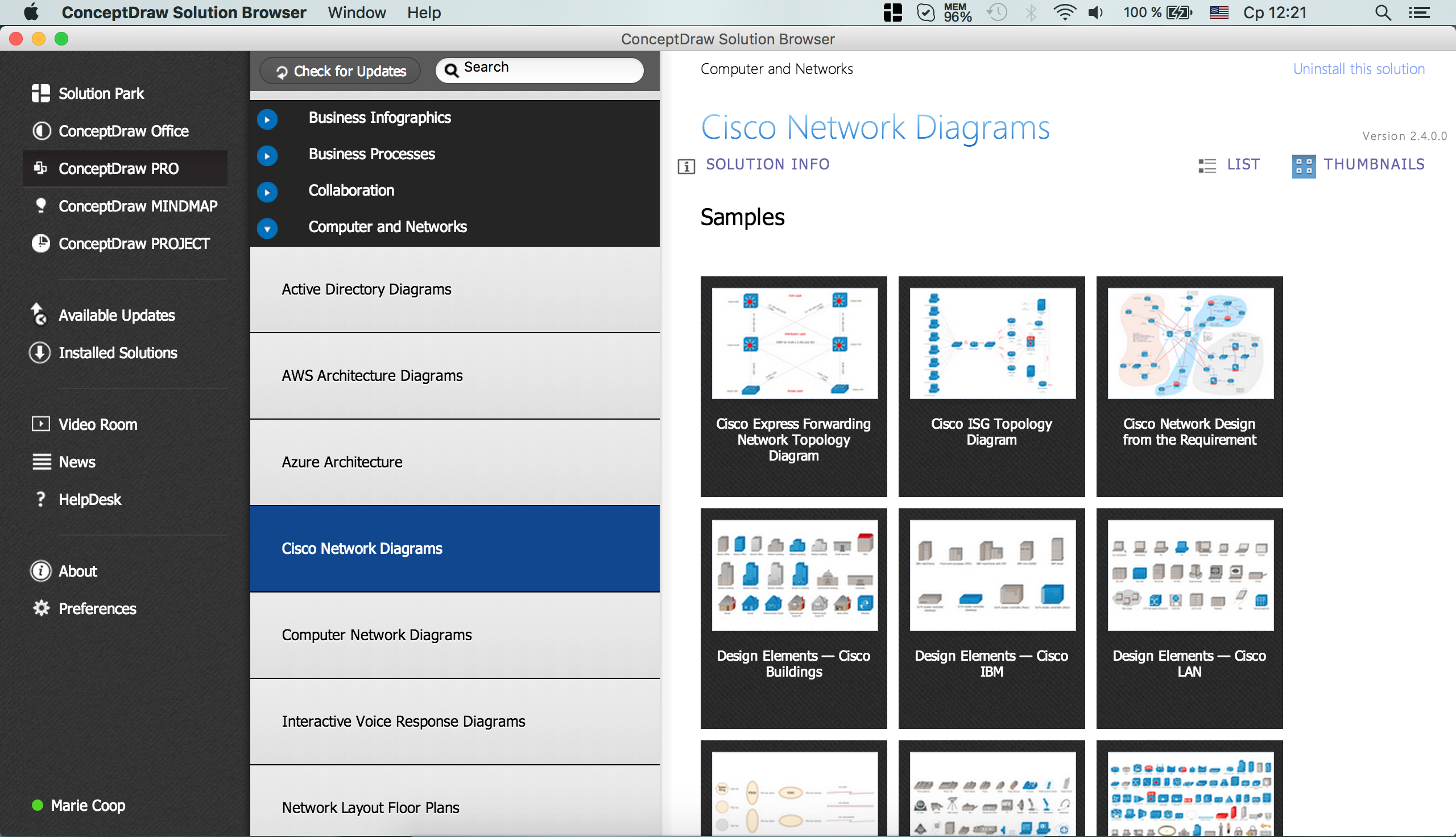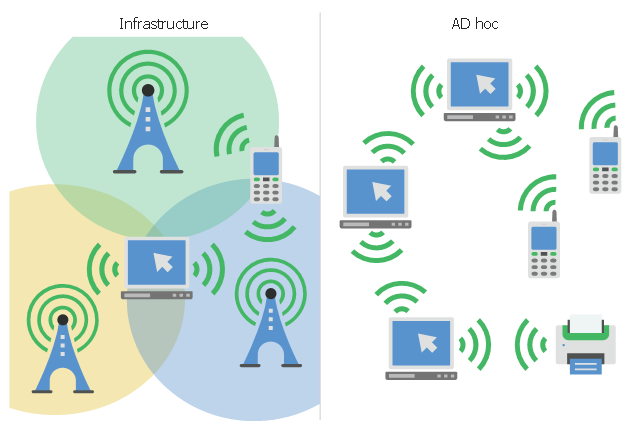The vector stencils library "Interactive voice response (IVR)" contains 32 symbols of devices and equipment for drawing interactive voice response (IVR) system network diagrams. Use these icons to develop, operate and maintain the IVR systems for inbound and outbound call centers and voice mail systems.
"Interactive voice response (IVR) is a technology that allows a computer to interact with humans through the use of voice and DTMF tones input via keypad. ...
DTMF decoding and speech recognition are used to interpret the caller's response to voice prompts. DTMF tones are entered via the telephone keypad.
Two main varieties of speech recognition are used in IVR: that based upon predefined grammars (used in "directed" dialogues), and that based on statistically trained language models (used in "natural language" dialogues). ...
Other technologies include using Text-To-Speech (TTS) to speak complex and dynamic information, such as e-mails, news reports or weather information. ...
An IVR can be deployed in several ways:
(1) Equipment installed on the customer premises.
(2) Equipment installed in the PSTN (Public Switched Telephone Network).
(3) Application service provider (ASP) / Hosted IVR.
IVR can be used to provide a more sophisticated voice mail experience to the caller. ...
An automatic call distributor (ACD) is often the first point of contact when calling many larger businesses. ...
Interactive voice response can be used to front-end a call center operation by identifying the needs of the caller." [Interactive voice response. Wikipedia]
The clip art example "Interactive voice response (IVR) - Vector stencils library" was created using the ConceptDraw PRO diagramming and vector drawing software extended with the Interactive Voice Response Diagrams solution from the Computer and Networks area of ConceptDraw Solution Park.
"Interactive voice response (IVR) is a technology that allows a computer to interact with humans through the use of voice and DTMF tones input via keypad. ...
DTMF decoding and speech recognition are used to interpret the caller's response to voice prompts. DTMF tones are entered via the telephone keypad.
Two main varieties of speech recognition are used in IVR: that based upon predefined grammars (used in "directed" dialogues), and that based on statistically trained language models (used in "natural language" dialogues). ...
Other technologies include using Text-To-Speech (TTS) to speak complex and dynamic information, such as e-mails, news reports or weather information. ...
An IVR can be deployed in several ways:
(1) Equipment installed on the customer premises.
(2) Equipment installed in the PSTN (Public Switched Telephone Network).
(3) Application service provider (ASP) / Hosted IVR.
IVR can be used to provide a more sophisticated voice mail experience to the caller. ...
An automatic call distributor (ACD) is often the first point of contact when calling many larger businesses. ...
Interactive voice response can be used to front-end a call center operation by identifying the needs of the caller." [Interactive voice response. Wikipedia]
The clip art example "Interactive voice response (IVR) - Vector stencils library" was created using the ConceptDraw PRO diagramming and vector drawing software extended with the Interactive Voice Response Diagrams solution from the Computer and Networks area of ConceptDraw Solution Park.
 Interactive Voice Response Diagrams
Interactive Voice Response Diagrams
Interactive Voice Response Diagrams solution extends ConceptDraw PRO v10 with samples, templates and library of ready-to-use vector stencils to help create Interactive Voice Response (IVR) diagrams illustrating a work of interactive voice response system, Voice-over-Internet Protocol (VoIP) diagrams and Action VoIP diagrams with representing voice actors on them.
"DTMF decoding and speech recognition are used to interpret the caller's response to voice prompts. DTMF tones are entered via the telephone keypad.
Two main varieties of speech recognition are used in IVR: that based upon predefined grammars (used in "directed" dialogues), and that based on statistically trained language models (used in "natural language" dialogues). Directed dialogues prompt the caller with specific questions or options. Natural language dialogues employ open questions (e.g. "How can I help you?"), are more conversational, and can interpret free-form responses.
Other technologies include using Text-To-Speech (TTS) to speak complex and dynamic information, such as e-mails, news reports or weather information. TTS is computer generated synthesized speech that is no longer the robotic voice traditionally associated with computers. Real voices create the speech in fragments that are spliced together (concatenated) and smoothed before being played to the caller." [Interactive voice response. Wikipedia]
This IVR diagram multipage example was created using the ConceptDraw PRO diagramming and vector drawing software extended with the Interactive Voice Response Diagrams solution from the Computer and Networks area of ConceptDraw Solution Park.
Two main varieties of speech recognition are used in IVR: that based upon predefined grammars (used in "directed" dialogues), and that based on statistically trained language models (used in "natural language" dialogues). Directed dialogues prompt the caller with specific questions or options. Natural language dialogues employ open questions (e.g. "How can I help you?"), are more conversational, and can interpret free-form responses.
Other technologies include using Text-To-Speech (TTS) to speak complex and dynamic information, such as e-mails, news reports or weather information. TTS is computer generated synthesized speech that is no longer the robotic voice traditionally associated with computers. Real voices create the speech in fragments that are spliced together (concatenated) and smoothed before being played to the caller." [Interactive voice response. Wikipedia]
This IVR diagram multipage example was created using the ConceptDraw PRO diagramming and vector drawing software extended with the Interactive Voice Response Diagrams solution from the Computer and Networks area of ConceptDraw Solution Park.
IVR
ConceptDraw PRO is a powerful diagramming and vector drawing software. Now, supplied with Interactive Voice Response Diagrams solution from the Computer and Networks area, ConceptDraw PRO became ideal for construction the IVR diagrams."Interactive Messaging Response (IMR).
As communications have migrated to multimedia so has automation. The introduction of Instant Messaging (IM) in contact centers is starting to take off. Agents can handle up to 6 different IM conversations at the same time and so agent productivity is increasing. IVR technology is being used to automate IM conversations using existing Natural Language Processing software. This is different from email handling as email automated response is typically based on key word spotting. IM conversations are different from email as IM is conversational. The use of text messaging abbreviations and smilies requires different grammars to those currently used for speech recognition. IM is also starting to replace text messaging on multimedia mobile handsets and is expected to become more widely used." [Interactive voice response. Wikipedia]
The IVR messaging system diagram example was created using the ConceptDraw PRO diagramming and vector drawing software extended with the Interactive Voice Response Diagrams solution from the Computer and Networks area of ConceptDraw Solution Park.
As communications have migrated to multimedia so has automation. The introduction of Instant Messaging (IM) in contact centers is starting to take off. Agents can handle up to 6 different IM conversations at the same time and so agent productivity is increasing. IVR technology is being used to automate IM conversations using existing Natural Language Processing software. This is different from email handling as email automated response is typically based on key word spotting. IM conversations are different from email as IM is conversational. The use of text messaging abbreviations and smilies requires different grammars to those currently used for speech recognition. IM is also starting to replace text messaging on multimedia mobile handsets and is expected to become more widely used." [Interactive voice response. Wikipedia]
The IVR messaging system diagram example was created using the ConceptDraw PRO diagramming and vector drawing software extended with the Interactive Voice Response Diagrams solution from the Computer and Networks area of ConceptDraw Solution Park.
 Computer and Networks Area
Computer and Networks Area
The solutions from Computer and Networks Area of ConceptDraw Solution Park collect samples, templates and vector stencils libraries for drawing computer and network diagrams, schemes and technical drawings.
Network Visualization with ConceptDraw PRO
ConceptDraw makes the entire process of network visualization easier thanks to the numerous ready-to-use objects included in the package for presentation of network equipment, LDAP directory symbols and many other objects that symbolize resources in most various representations."Unified Communications (UC) is the integration of real-time communication services such as instant messaging (chat), presence information, telephony (including IP telephony), video conferencing, data sharing (including web connected electronic whiteboards interactive whiteboards), call control and speech recognition with non-real-time communication services such as unified messaging (integrated voicemail, e-mail, SMS and fax). UC is not necessarily a single product, but a set of products that provides a consistent unified user-interface and user-experience across multiple devices and media-types.
In its broadest sense, UC can encompass all forms of communications that are exchanged via a network to include other forms of communications such as Internet Protocol Television (IPTV) and digital signage Communications as they become an integrated part of the network communications deployment and may be directed as one-to-one communications or broadcast communications from one to many.
UC allows an individual to send a message on one medium, and receive the same communication on another medium. For example, one can receive a voicemail message and choose to access it through e-mail or a cell phone. If the sender is online according to the presence information and currently accepts calls, the response can be sent immediately through text chat or video call. Otherwise, it may be sent as a non-real-time message that can be accessed through a variety of media." [Unified communications. Wikipedia]
The Unified communications (UC) diagram example was created using the ConceptDraw PRO diagramming and vector drawing software extended with the Computers and Communications solution from the Illustration area of ConceptDraw Solution Park.
In its broadest sense, UC can encompass all forms of communications that are exchanged via a network to include other forms of communications such as Internet Protocol Television (IPTV) and digital signage Communications as they become an integrated part of the network communications deployment and may be directed as one-to-one communications or broadcast communications from one to many.
UC allows an individual to send a message on one medium, and receive the same communication on another medium. For example, one can receive a voicemail message and choose to access it through e-mail or a cell phone. If the sender is online according to the presence information and currently accepts calls, the response can be sent immediately through text chat or video call. Otherwise, it may be sent as a non-real-time message that can be accessed through a variety of media." [Unified communications. Wikipedia]
The Unified communications (UC) diagram example was created using the ConceptDraw PRO diagramming and vector drawing software extended with the Computers and Communications solution from the Illustration area of ConceptDraw Solution Park.
- Interactive Voice Response Diagrams | Class Diagram Voice ...
- Interactive Voice Response Diagrams | Class Diagram Of Voice ...
- Interactive Voice Response System
- How to Create an Interactive Voice Response (IVR) Diagram in ...
- How to Create an Interactive Voice Response (IVR) Diagram in ...
- Interactive voice response (IVR)
- Interactive voice response (IVR) - Vector stencils library | Interactive ...
- IVR services diagram | Interactive voice response (IVR) - Vector ...
- Interactive Voice Response System | Cisco Multimedia, Voice ...
- Design elements - Interactive voice response (IVR) | Interactive ...
- Network Diagram Software IVR Services | Interactive voice response ...
- Interactive Voice Response Network Diagram
- Active Directory Diagrams | Interactive voice response (IVR) - Vector ...
- Interactive voice response (IVR) - Vector stencils library | Mobile Ivr ...
- Interactive Voice Response Network Diagram | Network ...
- Database Design | Interactive voice response (IVR) - Vector stencils ...
- Interactive voice response diagram - Template | Mobile TV Web ...
- What is IVR? | Interactive Voice Response Diagrams | How to Create ...
- Cisco Buildings. Cisco icons, shapes, stencils and symbols ...
- Interactive Voice Response Diagrams | Network Diagram Examples ...
---vector-stencils-library.png--diagram-flowchart-example.png)
---vector-stencils-library.png--diagram-flowchart-example.png)
---vector-stencils-library.png--diagram-flowchart-example.png)
---vector-stencils-library.png--diagram-flowchart-example.png)
---vector-stencils-library.png--diagram-flowchart-example.png)
---vector-stencils-library.png--diagram-flowchart-example.png)
---vector-stencils-library.png--diagram-flowchart-example.png)
---vector-stencils-library.png--diagram-flowchart-example.png)
---vector-stencils-library.png--diagram-flowchart-example.png)
---vector-stencils-library.png--diagram-flowchart-example.png)
---vector-stencils-library.png--diagram-flowchart-example.png)
---vector-stencils-library.png--diagram-flowchart-example.png)
---vector-stencils-library.png--diagram-flowchart-example.png)
---vector-stencils-library.png--diagram-flowchart-example.png)
---vector-stencils-library.png--diagram-flowchart-example.png)
---vector-stencils-library.png--diagram-flowchart-example.png)
---vector-stencils-library.png--diagram-flowchart-example.png)
---vector-stencils-library.png--diagram-flowchart-example.png)
---vector-stencils-library.png--diagram-flowchart-example.png)
---vector-stencils-library.png--diagram-flowchart-example.png)









